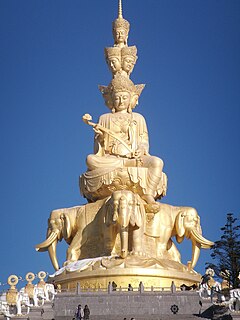Guan Puxian pusa xingfa jing
Guan Puxian pusa xingfa jing (觀普賢菩薩行法經), or “Sūtra on the Procedures for Visualizing the Bodhisattva Samantabhadra”,[1] a.k.a. the Samantabhadra Meditation Sūtra,[2] is a Mahayana sutra that teaches meditation and repentance practices. This text is often included in the so-called "Threefold Lotus Sutra," along with the Lotus Sutra and the Innumerable Meanings Sutra. It is considered to be a continuation (or epilogue) of the Lotus Sutra, being similar in content to the final chapter of the Lotus Sutra.[1]
The Princeton Dictionary states:
- In this scripture, the Buddha provides a detailed account of a meditation that will generate a vision of the bodhisattva Samantabhadra in all his glory, including the majesty of the snowy-white elephant on which he rides. Once Samantabhadra is visible, he will then reveal to the meditator all the buddhas of the ten directions, as well as various other pure lands and bodhisattvas. The scripture concludes with Samantabhadra’s explanation of how to conduct a repentance ritual that will purify the six sense organs, thus ensuring that the meditator will never again engage in unwholesome acts (akusala-karman) and will no longer be subject to rebirth in the three realms of existence (trilokadhātu).[1]
The text
The extant Chinese text of this sutra was translated by Dharmamitra between 424 and 442 CE (T09n277).[3] This version is believed to have followed two earlier translations, including one by Kumarajiva, which are now lost.[3][1] There is no extant Sanskrit recension of this text.[3][1]
According to Niwano (1989), "...because of its special emphasis on confession, it is sometimes referred to as the Sutra of Repentance."[4]
This text is also counted among a group of six visualization sutras found in the Chinese canon.[2]
Samantabhadra Bodhisattva
According to the sutra itself, Bodhisattva Samantabhadra ("Universal Virtue") was born in the east Pure Wonder Land and whose form was already mentioned clearly by the Buddha in the Avatamsaka Sutra.[5] The final chapter of the Lotus Sutra describes Samantabhadra as a perfect example of an adherent to the four practices:[6]
- He practices the teachings of the Lotus Sutra.
- He protects the Dharma teachings from every kind of persecution.
- He witnesses the merits obtained by those who practice the teachings and the punishments of those who slander the Dharma or persecute the practitioners.
- He proves that those who violate the Dharma can be delivered from their transgressions if they are sincerely penitent.
In the Guan Puxian pusa xingfa jing, the Buddha describes Samantabhadra's body as unlimited in size, and the range of his voice and the forms of his image are also described as unlimited. He possesses divine powers that enable him to come into the world when he wishes and shrink down to a smaller size. Through his wisdom-power, he appears transformed as if mounted on a white elephant to the people of Jambudvīpa defiled by the three heavy hindrances: arrogance, envy, and covetousness.[7] The Buddha Shakyamuni describes in detail the form of the elephant on which Universal Virtue is mounted.[8]
Samantabhadra rides the white elephant for the sole purpose of guiding the people of Jambudvīpa, or the sahā-world, through practices that are associated with their environment.[9] The bodhisattva riding on his white elephant is a symbolic image of Buddhist practice, as well as a representation of purity. The purity of the six sense organs is represented by the six tusks of Universal Virtue's white elephant.[9]
Notes
- ↑ 1.0 1.1 1.2 1.3 1.4 Buswell & Lopez 2014, s.v. Guan Puxian pusa xingfa jing.
- ↑ 2.0 2.1 Quinter 2018.
- ↑ 3.0 3.1 3.2 Reeves 2008, p. 4
- ↑ Niwano 1989, p. 72.
- ↑ Kato 1993, p. 348
- ↑ Niwano 1976, pp. 405–406
- ↑ Kato 1993, p. 349
- ↑ Kato 1993, pp. 349–350
- ↑ 9.0 9.1 Niwano 1976, p. 429
Sources
 Buswell, Robert E.; Lopez, Donald S. (2014), The Princeton Dictionary of Buddhism, Princeton University
Buswell, Robert E.; Lopez, Donald S. (2014), The Princeton Dictionary of Buddhism, Princeton University
- Kato, Bunno (1993). The Threefold Lotus Sutra. Tokyo: Kosei Publishing Company. (Translations only, without introduction, etc., available here.)
- Niwano, Nikkyo (1976), Buddhism For Today: A Modern Interpretation of the Threefold Lotus Sutra (PDF), Tokyo: Kōsei Publishing Co.
- Niwano, Nikkyo (1989), A Guide to the Threefold Lotus Sutra (PDF), Kōsei Publishing Co.
- Reeves, Gene (2008). The Lotus Sutra: A Contemporary Translation of a Buddhist Classic. Somerville: Wisdom Publications. ISBN 0861715713.
- Quinter, David (2018), Visualization/Contemplation Sutras, Oxford Bibliographies
| This article includes content from Samantabhadra Meditation Sutra on Wikipedia (view authors). License under CC BY-SA 3.0. |
